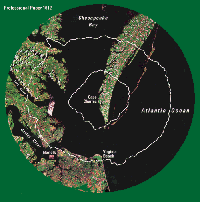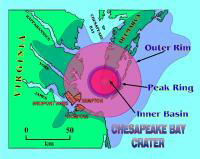2:00 p.m., Oct. 31, 2002--A space projectile that slammed into what is now the Chesapeake Bay about 35 million years ago left glass objects, or tektites, spread over much of the southern United States and the Gulf of Mexico, the Caribbean Sea and the northwest Atlantic Ocean, according to research by University of Delaware geology professor Billy Price Glass.
 |
| The inner basin and outer rim of the Chesapeake Bay Crater are outlined in white in this illustration. The 50-mile-wide impact structure, which lies hidden beneath the bay and coastal sediments, is the largest in the United States. |
Glass presented those findings during the 114th annual meeting of the Geological Society of America to be held Oct. 27-30 in Denver. Approximately 6,300 geoscientists from around the world are expected to attend.
The Chesapeake Bay Impact Structure, located at the mouth of the Chesapeake, is the largest crater in the United States. Over the years, it has filled with sediment and as a result was not discovered until the early 1990s.
The crater was formed when a meteorite or comet a few kilometers in diameter collided with Earth. At the time, the area of impact was a shallow sea.
Glass has been studying the tektites sent flying on impact and has found evidence of their presence in the Gulf of Mexico, the Caribbean Sea and the northwest Atlantic.
He has found that the distribution of tektites associated with that event is consistent with “a ray pattern,” and he said “the thickness of the ejecta layer decreases and the percent glass increases away from the Chesapeake Bay Impact Structure.”
 |
| Billy Price Glass holds joint appointments in geology and marine studies and chaired the UD geology department from 1986-96. |
The pattern and the thickness of the ejecta layer indicate the source crater diameter should be about 46 kilometers, which he said “is close to the diameter of the central basin of the Chesapeake Bay Impact Structure.”
Glass said that in the late 1930s, geologists recognized that glass objects found in Grimes County, Texas, and called black diamonds by the locals, were related to glass objects found in other parts of the world. Those objects were collectively referred to as tektites, from a Greek word meaning melted or molten.
Similar glass objects were reported from Georgia in the late 1950s, he said, and the occurrence of tektites in Texas and Georgia became know as the North American tektite strewn field. The tektites in the strewn field are about 35 million years old.
“I began searching for microscopic versions of the North American tektites, known as microtektites, in marine sediments in the late 1960s,” Glass said. “I had already found microtektites, associated with two other tektites strewn fields, in deep-sea sediment cores. Before I could find them, they were found in a sediment core taken in the Caribbean Sea by a professor from the State University of New York at Binghamton.
“After that initial discovery, I was quickly able to find them at another site in the Caribbean Sea and one in the Gulf of Mexico. Since then, they were found in marine sediments on Barbados and at two sites on the upper continental slope off New Jersey.”
In the meantime, Glass said, he and other geologists concluded that the North American tektites and microtektites were surface deposits that were melted and splashed out over large areas of the earth’s surface to form the tektite-strewn fields.
Measurements of strontium and neodymium isotopic ratios indicated the ages of the source rocks and suggested that the source crater must be on the Atlantic or Gulf coastal plain or the adjacent continental shelf.
The microtektites found in the sites off New Jersey are much more abundant and occur in a much thicker layer than those found in the Gulf of Mexico, Caribbean Sea and Barbados. In addition, the layer off New Jersey contains abundant unmelted impact ejecta that show evidence of high pressure and high temperature, as would be produced by “shock metamorphism” during impact cratering, Glass said.
This suggested that the source crater was nearby, he said.
Glass said that Wylie Poag, David Powers and colleagues at the U.S. Geological Survey began a search for the source crater and discovered a buried impact crater at the mouth of the Chesapeake Bay that is about 90 kilometers in diameter.
 Based on its age, location and size it is believed to be the source crater for the North American tektites and microtektites. Thus, Glass said, the tektites found in Texas and Georgia and the microtektites found in the Gulf of Mexico, Caribbean Sea, on Barbados, and off New Jersey are distal impact ejecta from this impact crater. Based on its age, location and size it is believed to be the source crater for the North American tektites and microtektites. Thus, Glass said, the tektites found in Texas and Georgia and the microtektites found in the Gulf of Mexico, Caribbean Sea, on Barbados, and off New Jersey are distal impact ejecta from this impact crater.
Glass’s Geological Society of America talk will deal with what is known about the distal ejecta from the Chesapeake Bay crater.
“One of the interesting findings is the discovery of a high pressure form of the mineral zircon, a zirconium silicate mineral that is sometimes used in jewelry,” Glass said. “This mineral had not been seen before, and, thus, we were able to name it. We named it after a researcher in Australia who first produced this compound in high-pressure laboratory experiments in 1969. His name is Alan F. Reid, and we named the mineral reidite.”
Article by Neil Thomas
|

